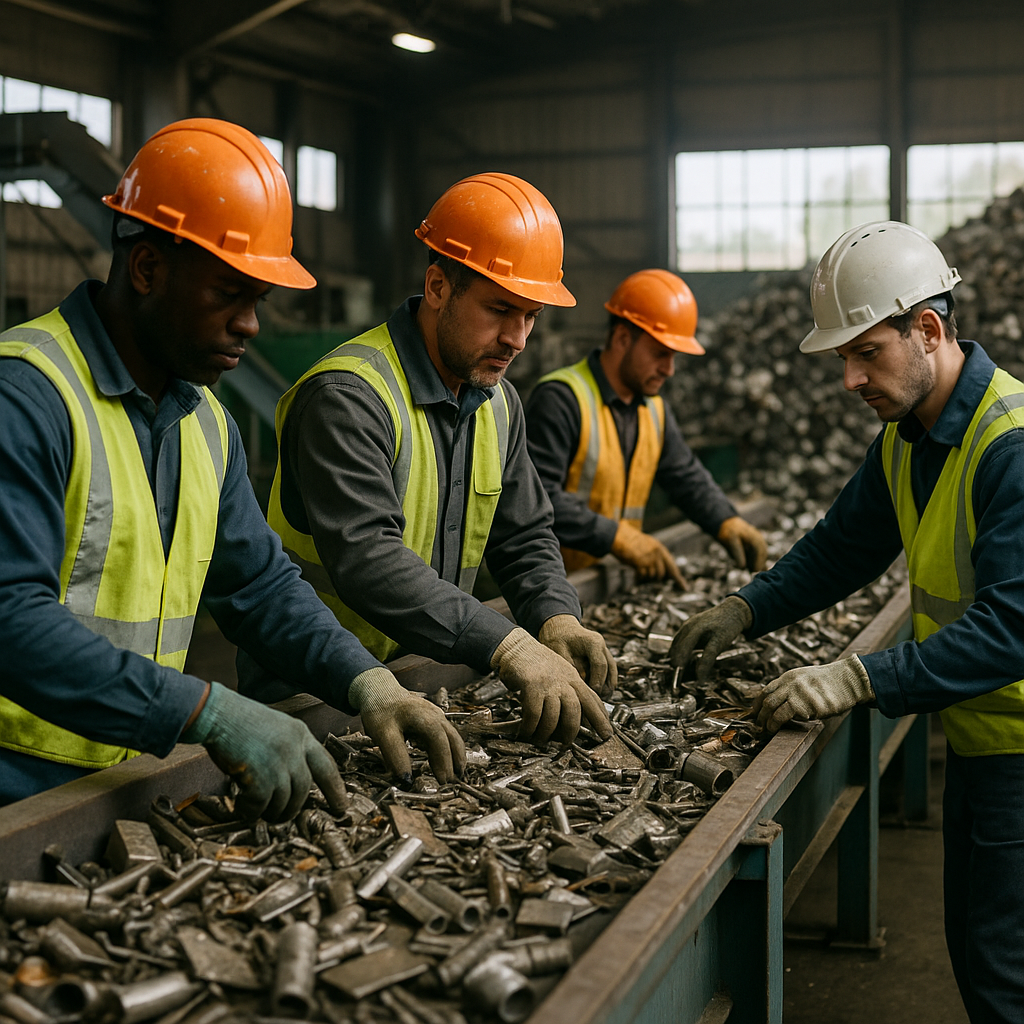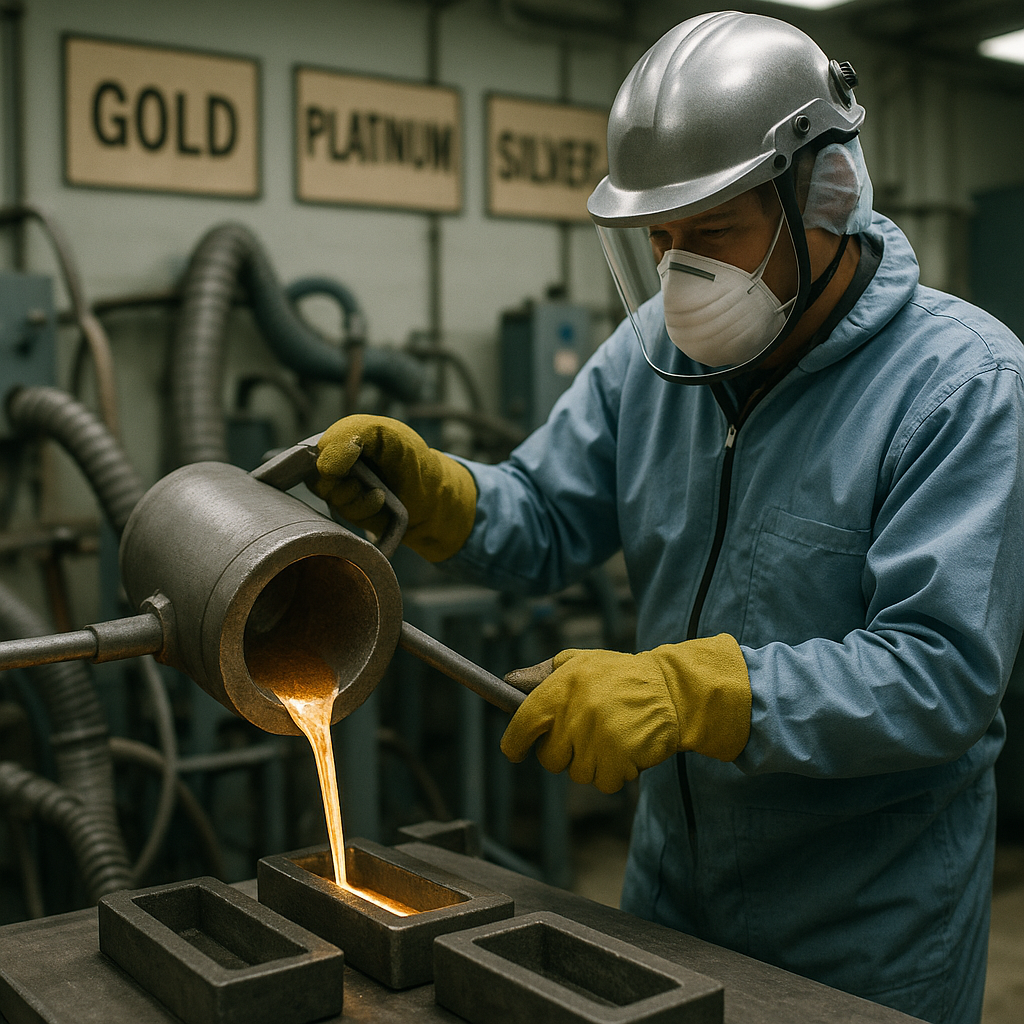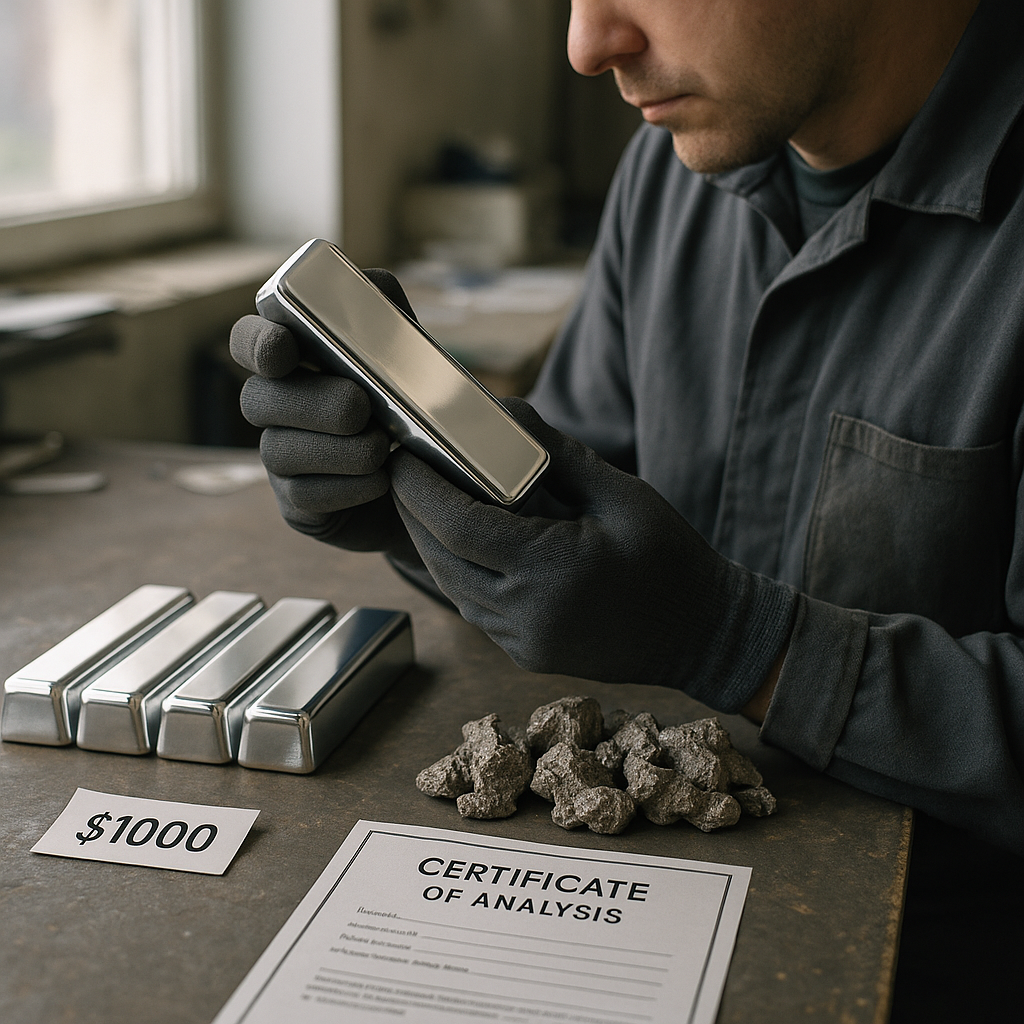5901 Botham Jean Blvd, Dallas, TX 75215
Purification Process for Recycled Metal: Methods, Benefits, and Industry Applications
October 1, 2025Metal purification is the crucial step that transforms scrap metal into valuable manufacturing resources. This essential stage in the recycling process removes contaminants from molten metal, restoring its key properties. Without effective purification, recycled metals cannot match the quality or performance of their virgin counterparts.
The purification stage follows collection, sorting, shredding, and melting. Once metals are molten, they need to be cleansed of impurities that could compromise their integrity. These contaminants range from non-metallic particles to unwanted metal alloys that would weaken the final product.
Several techniques have been developed to ensure recycled metals meet industry standards. Electrolysis is one of the most effective methods for metals like copper and aluminum. This process uses electrical currents to separate pure metal from impurities. The metal deposits at the cathode, while contaminants accumulate as “anode mud” at the bottom of the processing vessel.
What Are the Key Steps in Metal Recycling Before Purification?

Metal recycling is a systematic process that transforms discarded scrap into valuable resources ready for purification. Each preliminary step plays a vital role in preparing metals for their rebirth into new products. Understanding these initial stages reveals how the industry maximizes resource recovery while minimizing environmental impact.
Collection: The Critical First Step
The recycling journey begins with collecting from various sources. Scrap metal arrives from construction sites, manufacturing facilities, demolition projects, and residential areas. Collection teams gather everything from old appliances and automotive parts to industrial waste and building materials.
During this phase, materials are broadly categorized as either ferrous (containing iron) or non-ferrous (such as aluminum, copper, and brass). This initial sorting streamlines subsequent processing steps. The thoroughness of collection efforts directly impacts the amount of metal that can be reclaimed rather than sent to landfills.
Large-scale industrial operations often use designated bins and containers to facilitate efficient collection. For manufacturing facilities, specialized roll-off containers allow for organized accumulation of metal waste before transport to recycling centers.
Sorting: Separating Metal Types
Once collected, the scrap undergoes thorough sorting to ensure quality and maximize value. This critical step prevents cross-contamination between different metal types, which would compromise the purity of the recycled product.
Sorting employs both manual and mechanical methods. Large magnets efficiently separate ferrous metals like steel and iron from the mix, while non-ferrous metals require more sophisticated techniques. Advanced technologies such as eddy current separators, optical sorting systems, and density separation equipment help identify and group similar metals.
Workers also perform visual inspections to catch items that automated systems might miss. The goal is to create clean, homogeneous batches of specific metals that will yield high-quality recycled material. Proper sorting dramatically improves the efficiency of subsequent processing steps.
Processing: Size Reduction and Surface Preparation
After sorting, the material moves to processing stages where large pieces enter industrial shredders, crushers, or hydraulic shears to break them down into smaller fragments. This size reduction serves two crucial purposes in preparing for purification.
First, it increases the surface area of the metal, allowing for more efficient melting in later stages. Second, processing helps remove any remaining non-metallic attachments or coatings. Specialized equipment strips insulation from copper wire and removes paint or other coatings from various metal products.
The processing step also includes compacting or baling the sorted metal into dense, manageable forms. Hydraulic balers compress the metal into compact bundles that are easier to transport and feed into furnaces. This compression reduces transportation costs and improves furnace efficiency.
Melting: The Final Preparation Before Purification
The final pre-purification step involves melting the processed metal in specialized furnaces designed for specific metal types. These furnaces operate at carefully controlled temperatures to ensure complete melting without damaging the material properties.
During melting, some impurities naturally rise to the surface as slag, beginning the purification process. Different metals require different furnace technologies – aluminum might be processed in reverberatory furnaces, while steel typically uses electric arc or induction furnaces.
The melting process transforms the varied shapes and sizes of scrap into a homogeneous molten form ready for comprehensive purification. This step prepares the metal for the removal of remaining contaminants through methods such as electrolysis, chemical treatments, or further refinement.
Why These Preliminary Steps Matter
These four pre-purification stages determine the quality of the final recycled product. Efficient collection ensures maximum recovery of valuable resources. Thorough sorting guarantees material purity. Proper processing improves melting efficiency. Controlled melting creates consistent material ready for purification.
Each stage builds on the previous one, creating a process that transforms mixed, contaminated scrap into organized, prepared material. The care taken during these preliminary steps directly affects the quality, efficiency, and economics of the entire recycling operation.
Without these carefully sequenced preparation steps, the purification process would be significantly more energy-intensive and less effective. By handling each phase with precision, recyclers produce high-quality recycled metals that match the properties of virgin materials while using a fraction of the energy.
What Purification Techniques Are Used for Different Types of Metals?

Metal purification is essential to remove unwanted elements that compromise quality and performance. Different metals require specific purification methods based on their chemical properties and the types of impurities present. The purity of metals directly impacts their conductivity, strength, and overall functionality in various applications.
Electrolytic Purification
Electrolysis is one of the most effective methods for purifying many metals. This process uses electricity to separate pure metal from impurities. During electrolysis, the impure metal serves as the anode (positive electrode) while a thin sheet of pure metal functions as the cathode (negative electrode).
Copper refining exemplifies electrolytic purification in action. When current passes through a copper sulfate solution, copper ions migrate from the impure anode to the cathode, where they deposit as pure copper. Impurities either remain in solution or collect as “anode sludge” at the bottom of the cell. This method achieves copper with 99.99% purity, essential for electrical applications.
Aluminum production relies heavily on electrolysis through the Hall-Héroult process. Since aluminum bonds strongly with oxygen, it requires a powerful electrolytic method to extract it from aluminum oxide. The process takes place in a cell containing molten cryolite at temperatures around 960°C, with carbon anodes and a carbon-lined steel shell serving as the cathode.
Chemical Treatment Methods
Chemical purification involves using reagents to selectively remove impurities from metals. These treatments can target specific contaminants without affecting the base metal. The process often employs acids, bases, or other compounds that react with impurities but not with the metal itself.
Zinc purification frequently uses chemical methods. In the hydrometallurgical process, zinc-containing materials are leached with sulfuric acid, producing a solution containing zinc and impurities. Chemical agents then precipitate the impurities, leaving a purified zinc solution ready for recovery.
Gold refining employs aqua regia (a mixture of nitric and hydrochloric acids) to dissolve gold while leaving behind certain impurities. The gold is later precipitated from the solution as a pure metal, achieving purities exceeding 99.9%.
Thermal Purification and Skimming
Many metals undergo thermal purification, which involves controlled heating to separate impurities based on different melting points. Skimming is an important thermal technique where impurities floating to the surface of molten metal are physically removed.
Iron undergoes purification during steelmaking through slag skimming. When limestone is added to molten iron, it combines with impurities like silicon and phosphorus to form a slag that floats on the surface and can be skimmed off. This process is fundamental to producing high-quality steel.
Tin refining also uses the principles of thermal purification. When heated to just above its melting point, tin flows away from higher-melting impurities, which remain solid and can be removed. This process, called liquation, has been used since ancient times.
Advanced Plasma Processing
Plasma processing represents cutting-edge technology for purifying specialty metals. This method employs an ionized gas (plasma) at extremely high temperatures to separate and purify metals with high melting points or reactive properties.
Titanium purification relies heavily on plasma arc technology. The transferred arc plasma system creates temperatures exceeding 10,000°C, which completely melts titanium and allows for the separation of impurities. This technique produces titanium with exceptional purity for aerospace and medical applications.
Zirconium, another specialty metal, undergoes plasma processing to achieve the high purity required for nuclear applications. The extreme heat of the plasma breaks down zirconium compounds and removes oxygen, nitrogen, and other contaminants that would compromise its performance in nuclear reactors.
Metal-Specific Purification Approaches
Each metal requires a tailored purification approach based on its unique properties. Precious metals like silver undergo multiple purification steps, often combining chemical and electrolytic methods. Silver first undergoes chemical treatment with nitric acid and then passes through an electrolytic cell to achieve high purity.
Magnesium purification typically involves both thermal and chemical processes. The Pidgeon process reduces magnesium oxide with silicon at high temperatures to form pure magnesium vapor, which is then condensed and collected.
Nickel refining demonstrates how different techniques can be combined. The Mond process uses carbon monoxide to form nickel carbonyl gas, which then decomposes at higher temperatures to deposit pure nickel metal, achieving purities above 99.97%.
| Purification Method | Metals | Applications |
|---|---|---|
| Electrolysis | Copper, Aluminum | Electrical applications (Copper), Aluminum production (Hall-Héroult process) |
| Chemical Treatment | Zinc, Gold | Purifying zinc solutions, Gold refining with aqua regia |
| Thermal Purification (Skimming) | Iron, Tin | Steelmaking (slag removal), Tin refining through liquation |
| Advanced Plasma Processing | Titanium, Zirconium | Aerospace (Titanium), Nuclear applications (Zirconium) |
| Combination Purification Methods | Nickel | Achieving high purity (Mond Process) |
The choice of purification technique ultimately depends on factors including the initial purity of the metal, the specific impurities present, the final purity required, economic considerations, and environmental concerns. As technology advances, new purification methods continue to emerge, enabling the production of ever purer metals for increasingly demanding applications.
How Does Purification Impact the Quality and Value of Recycled Metal?

Purification is a crucial step that transforms scrap metal from waste into a valuable resource. During this process, contaminants rise to the surface as slag or are removed through specialized chemical treatments. Without proper purification, recycled metals would retain impurities that compromise their structural integrity and functional properties.
The purification stage employs various techniques depending on the metal type and desired quality outcome. Electrolysis uses electrical currents to separate pure metal from impurities with exceptional precision. For some metals, chemical baths dissolve contaminants while preserving the base metal. Advanced facilities may use thermal methods that rely on the different melting points of metals and their impurities for separation.
Quality Enhancement Through Purification
The quality difference between purified and non-purified recycled metal is substantial. Properly purified aluminum exhibits the same lightweight strength and corrosion resistance as virgin material. Steel that undergoes rigorous purification retains its tensile strength and durability, essential for construction applications. Copper, when thoroughly purified, maintains its exceptional electrical conductivity needed for wiring and electronic components.
Industry standards demand specific purity levels achievable only through proper purification. Manufacturing specifications often require metals to contain less than 0.1% of certain impurities. Meeting these requirements ensures recycled metals perform identically to their virgin counterparts in demanding applications. Quality testing after purification confirms these standards are met before the material enters the manufacturing supply chain.
Economic Value Creation
The economic impact of purification on recycled metal value is significant. Purified aluminum can sell for up to five times more than contaminated scrap. High-purity copper commands premium prices in electrical manufacturing markets. Steel that meets industry standards through purification processes sells at rates comparable to new steel while costing significantly less to produce.
The value differential stems from the expanded application potential of purified metals. Impure recycled metals might only serve basic, non-critical applications. In contrast, thoroughly purified metals qualify for use in automotive components, building infrastructure, precision machinery, and even medical equipment. This versatility dramatically increases market demand and price points for well-purified recycled metals.
Environmental Benefits of Purification
Purification technology delivers substantial environmental advantages beyond the inherent benefits of recycling. Using purified recycled aluminum instead of virgin material reduces energy consumption by 95%. The purification process for steel recycling saves approximately 75% of the energy required for new steel production, directly translating into reduced carbon emissions.
The environmental calculation becomes even more favorable when considering that purification enables multiple recycling cycles without quality degradation. Unlike many materials that degrade with each recycling iteration, metals can be repeatedly purified and reused indefinitely without loss of performance. This recyclability creates a truly circular material economy for metals.
Manufacturing Applications
Purified recycled metals serve critical roles across diverse industries. The automotive sector uses purified aluminum for lightweight body components that improve fuel efficiency. Construction relies on purified recycled steel for structural beams that adhere to strict building codes. Electronics manufacturers depend on highly purified copper for circuit boards where conductivity standards are non-negotiable.
The aerospace industry, perhaps the most demanding of all, increasingly accepts purified recycled titanium and aluminum alloys for non-critical components. Food and beverage companies utilize purified recycled aluminum for packaging that must meet stringent safety regulations. These high-value applications would be impossible without the advanced purification technologies employed in modern metal recycling.
| Metal | Primary Purification Technique | Applications |
|---|---|---|
| Copper | Electrolysis | Electrical components, wiring |
| Aluminum | Electrolysis | Aerospace components, packaging |
| Steel | Thermal purification and skimming | Construction, automotive components |
| Tin | Liquation (Thermal Purification) | Alloys, coatings |
| Zinc | Chemical treatment | Galvanization, batteries |
| Gold | Chemical treatment (Aqua regia) | Jewelry, electronics |
Purification Challenges and Innovations
Despite its benefits, metal purification presents technical challenges that recyclers must overcome. Complex alloys require sophisticated separation techniques to isolate the constituent metals. Some contaminants bond thoroughly with base metals, making conventional purification methods ineffective. The energy requirements of certain purification processes can offset some environmental gains if not carefully managed.
The industry continues to innovate with new purification technologies that address these challenges. Advanced sensor systems can now detect contaminants at previously undetectable levels. Energy-efficient furnaces reduce the carbon footprint of thermal purification methods. Hydrometallurgical techniques offer less energy-intensive alternatives to traditional smelting for certain metals, making the process both more effective and environmentally friendly.
The pursuit of higher purity levels drives continuous improvement in metal recycling technology. These innovations ensure that as manufacturing standards become more exacting, recycled metals can continue to meet or exceed quality requirements while maintaining cost and environmental advantages over virgin materials.
Conclusion: The Future of Recycled Metal Purification
Metal recycling and purification technologies are leading our transition to a more sustainable future. The advancements discussed in this article—such as AI-powered sorting systems and innovative hydrometallurgical processes—are transforming how we recover and purify metals from waste streams. These technologies not only conserve finite resources but also significantly reduce energy consumption, with recycled aluminum requiring up to 95% less energy than producing new aluminum from raw materials.
The impact of purified recycled metals extends beyond environmental benefits. Economically, these advancements create jobs, stabilize supply chains, and reduce costs across various industries. As purification technologies continue to advance, recycled metals increasingly meet the stringent quality requirements of aerospace, automotive, and construction sectors, demonstrating that sustainability and performance can coexist. For organizations aiming to enhance recycling initiatives and meet sustainability goals, contact Okon Recycling at 214-717-4083.
